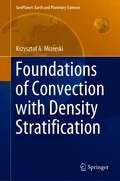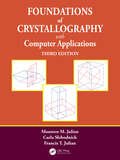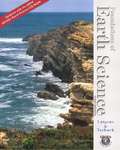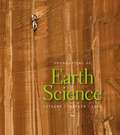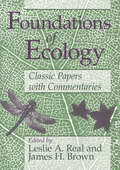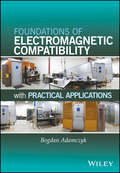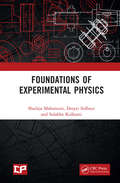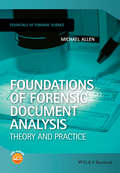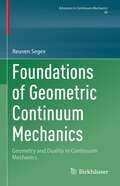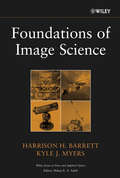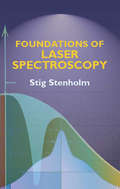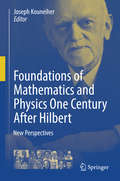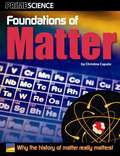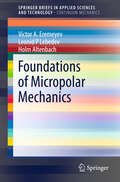- Table View
- List View
Foundations of Convection with Density Stratification (GeoPlanet: Earth and Planetary Sciences)
by Krzysztof A. MizerskiThis book continues the process of systematization of knowledge about convection. It is important to put the current knowledge on weakly and strongly stratified convection in order, and provide a comprehensive description of the marginal, weakly nonlinear and fully developed stages of convective flow in both cases. The book provides a short compendium of knowledge on the linear and weakly nonlinear limits of the Boussinesq convection, and a review of the theory on fully developed Boussinesq convection. The third chapter is devoted to a detailed derivation and a study of the three aforementioned stages of stratified (anelastic) convection, with a full solution in the marginal stage provided for the first time. Detailed and systematic explanations are given. The book is intended mainly as a textbook for courses on hydrodynamics and convective flows, for the use of lecturers and students; however, it also serves for the entire scientific community as a practical reference.
Foundations of Criminal Forensic Neuropsychology: Bridging Mind, Law, and Criminal Justice
by K. Jayasankara ReddyThis volume, written by experts from academia, research institutions, police organizations, and private industry, tackles the most pressing challenges in the global security domain. Focusing on the protection of critical infrastructures, counterterrorism, cybercrime, and border security, this book examines how advanced ICT solutions can address emerging threats in the modern security landscape. It delves into the application of artificial intelligence, the dark web, and large-scale data analysis to combat serious and organized crime, manage disasters, and protect national security. Through a collection of case studies from over 30 large-scale research and development projects, this book provides practical insights into the operational challenges and security gaps faced by security professionals worldwide. It explores not only the theoretical aspects of global security but also identifies real-world solutions for contemporary issues such as cybercrime, border surveillance, and crisis management. The book offers a unique, multidisciplinary perspective on security policy, highlighting the complexities of securing critical infrastructures and combating global threats. By focusing on both the operational and technological aspects of security, it presents actionable insights for policy makers, security professionals, and researchers. This book is ideal for professionals and scholars in the fields of global security, cybersecurity, law enforcement, and public policy, as well as those interested in the evolving role of technology in safeguarding critical infrastructure and managing crises.
Foundations of Crystallography with Computer Applications
by Maureen M. Julian Carla Slebodnick Francis T. JulianThe third edition of Foundations of Crystallography with Computer Applications is a textbook for undergraduate and graduate students studying the solid state in chemistry, physics, materials science, geological sciences, and engineering. It takes a straightforward, logical approach to explaining how atoms are arranged in crystals and how crystal systems are related to each other. New to this edition is the inclusion of interactive Starter Programs in Python, which allow the students to focus on concepts and not treat crystallographic programs as "black boxes." Since many students have trouble visualizing three dimensional constructions, this book begins with detailed discussions in two dimensions leading up to the three-dimensional understanding. The first seven chapters introduce the fundamental principles, Chapter 8 suggests student projects, and the final seven chapters give detailed examples of the seven crystal systems. Key features: Uses Python, the leading open-source scientific language, with libraries including NumPy for matrix manipulations, Matplotlib for graphics, and Mplot3d for interactive 3-D modeling. Provides a gentle introduction to Python with Jupyter Notebooks, which combine interactive code and formatted documentation. Color codes both point group and space group diagrams using a new scheme devised by the author to emphasize the change of handedness of the symmetry operations and their consequences. Suggests student projects with data that can be found in the free Teaching Subset of the Cambridge Structural Database, the American Mineralogist Crystal Structure Database, and others. This book’s thorough but accessible style gives students a strong foundation in the subject. Over one thousand students have successfully used this book at Virginia Tech, and many more will continue to benefit from this new edition.
Foundations of Crystallography with Computer Applications
by Maureen M. JulianTaking a straightforward, logical approach that emphasizes symmetry and crystal relationships, Foundations of Crystallography with Computer Applications, Second Edition provides a thorough explanation of the topic for students studying the solid state in chemistry, physics, materials science, geological sciences, and engineering. It is also written
Foundations of Dynamic Economic Analysis
by Michael R. CaputoPresenting a thorough introductory exposition of optimal control theory, this work differs from the existing textbooks on the subject due to its emphasis on the economic interpretation of the mathematics and the qualitative properties of the solutions. Moreover, it is a modern exposition of optimal control theory in that it presents numerous complementary methods. It is aimed at first-year and second-year PhD students in economics, agricultural and resource economics, operations research, management science, and applied mathematics.
Foundations of Earth Science (3rd edition)
by Edward J. Tarbuck Frederick K. LutgensThis book offers a user-friendly overview of the physical environment. It retains the hallmarks expected from author's reader-friendly writing style, carefully crafted art program, and coverage of the most recent current events. It discusses key topics such as Earth materials, earth's external and internal processes, Earth's history, the global ocean, and the atmosphere.
Foundations of Earth Science 6th Edition
by Frederick K. Lutgens Edward J. Tarbuck.Earth Science by Lutgens and Tarbuck is designed for introductory courses in Earth science. It's a non-technical survey with broad, up-to-date coverage of basic topics and principles in geology, oceanography, meteorology, and astronomy. As in previous editions, the main focus is to increase your understanding of basic Earth science principles.
Foundations of Ecological Resilience
by C. S. Holling Lance H. Gunderson Craig Reece AllenEcological resilience provides a theoretical foundation for understanding how complex systems adapt to and recover from localized disturbances likehurricanes, fires, pest outbreaks, and floods, as well as large-scale perturbations such as climate change. Ecologists have developed resilience theory over the past three decades in an effort to explain surprising and nonlinear dynamics of complex adaptive systems. Resilience theory is especially important to environmental scientists for its role in underpinning adaptive management approaches to ecosystem and resource management. Foundations of Ecological Resilience is a collection of the most important articles on the subject of ecological resilience--those writings that have defined and developed basic concepts in the field and help explain its importance and meaning for scientists and researchers. The book's three sections cover articles that have shaped or defined the concepts and theories of resilience, including key papers that broke new conceptual ground and contributed novel ideas to the field; examples that demonstrate ecological resilience in a range of ecosystems; and articles that present practical methods for understanding and managing nonlinear ecosystem dynamics. Foundations of Ecological Resilience is an important contribution to our collective understanding of resilience and an invaluable resource for students and scholars in ecology, wildlife ecology, conservation biology, sustainability, environmental science, public policy, and related fields.
Foundations of Ecology: Classic Papers with Commentaries
by James H. Brown Leslie A. RealAssembled here for the first time in one volume are forty classic papers that have laid the foundations of modern ecology. Whether by posing new problems, demonstrating important effects, or stimulating new research, these papers have made substantial contributions to an understanding of ecological processes, and they continue to influence the field today. The papers span nearly nine decades of ecological research, from 1887 on, and are organized in six sections: foundational papers, theoretical advances, synthetic statements, methodological developments, field studies, and ecological experiments. Selections range from Connell's elegant account of experiments with barnacles to Watt's encyclopedic natural history, from a visionary exposition by Grinnell of the concept of niche to a seminal essay by Hutchinson on diversity. Six original essays by contemporary ecologists and a historian of ecology place the selections in context and discuss their continued relevance to current research. This combination of classic papers and fresh commentaries makes Foundations of Ecology both a convenient reference to papers often cited today and an essential guide to the intellectual and conceptual roots of the field. Published with the Ecological Society of America.
Foundations of Ecology: \Classic Papers with Commentaries
by Leslie A. Real and James H. BrownAssembled here for the first time in one volume are forty classic papers that have laid the foundations of modern ecology. Whether by posing new problems, demonstrating important effects, or stimulating new research, these papers have made substantial contributions to an understanding of ecological processes, and they continue to influence the field today. The papers span nearly nine decades of ecological research, from 1887 on, and are organized in six sections: foundational papers, theoretical advances, synthetic statements, methodological developments, field studies, and ecological experiments. Selections range from Connell's elegant account of experiments with barnacles to Watt's encyclopedic natural history, from a visionary exposition by Grinnell of the concept of niche to a seminal essay by Hutchinson on diversity. Six original essays by contemporary ecologists and a historian of ecology place the selections in context and discuss their continued relevance to current research. This combination of classic papers and fresh commentaries makes Foundations of Ecology both a convenient reference to papers often cited today and an essential guide to the intellectual and conceptual roots of the field. Published with the Ecological Society of America.
Foundations of Elastoplasticity: Subloading Surface Model
by Koichi HashiguchiThis book is the standard text book for elastoplasticity/viscoplasticity which is explained comprehensively covering the rate-independent to -dependent finite deformations of metals, soils, polymers, crystal plasticity, etc. and the friction phenomenon. Concise explanations on vector-tensor analysis and continuum mechanics are provided first, covering the underlying physical concepts, e.g. various time-derivatives, pull-back and push-forward operations, work-conjugacy and multiplicative decomposition of deformation gradient tensor. Then, the rigorous elastoplastic/viscoplastic model, called the subloading surface model, is explained comprehensively, which is based on the subloading surface concept to describe the continuous development of the plastic/viscoplastic strain rate as the stress approaches to the yield surface, while it can never be described by the other plasticity models, e.g. the Chaboche-Ohno and the Dafalias-Yoshida models assuming the purely-elastic domain. The main features of the subloading surface model are as follows: 1) The subloading surface concept underling the cyclic plasticity is introduced, which insists that the plastic deformation develops as the stress approaches the yield surface. Thus, the smooth elastic-plastic transition leading to the continuous variation of the tangent stiffness modulus is described always.2) The subloading-overstress model is formulated by which the elastoplastic deformation during the quasi-static loading and the viscoplastic deformation during the dynamic and impact loading can be described by the unified equation. Then, only this model can be used to describe the deformation in the general rate of deformation, disusing the elastoplastic constitutive equation.3) The hyperelastic-based (visco)plasticity based on the multiplicative decomposition of deformation gradient tensor and the subloading surface model is formulated for the exact descriptions of the finite elastic and (visco)plastic deformations.4) The subloading-friction model is formulated for the exact description of the dry and the fluid (lubricated) frictions at the general rate of sliding from the static to the impact sliding.Thus, all the elastic and inelastic deformation/sliding phenomena of solids can be described accurately in the unified equation by the subloading-overstress model. The subloading surface model will be engraved as the governing law of irreversible deformation of solids in the history of solid mechanics.
Foundations of Electromagnetic Compatibility with Practical Applications
by Bogdan AdamczykThere is currently no single book that covers the mathematics, circuits, and electromagnetics backgrounds needed for the study of electromagnetic compatibility (EMC). This book aims to redress the balance by focusing on EMC and providing the background in all three disciplines. This background is necessary for many EMC practitioners who have been out of study for some time and who are attempting to follow and confidently utilize more advanced EMC texts. The book is split into three parts: Part 1 is the refresher course in the underlying mathematics; Part 2 is the foundational chapters in electrical circuit theory; Part 3 is the heart of the book: electric and magnetic fields, waves, transmission lines and antennas. Each part of the book provides an independent area of study, yet each is the logical step to the next area, providing a comprehensive course through each topic. Practical EMC applications at the end of each chapter illustrate the applicability of the chapter topics. The Appendix reviews the fundamentals of EMC testing and measurements.
Foundations of Experimental Physics
by Shailaja Mahamuni Deepti Sidhaye Sulabha KulkarniAll solids are composed of atoms or molecules and in order to explain their behavior, experiments and theories came forward. Simultaneously, many new materials were synthetically and systematically developed in the laboratories, properties of which needed to be understood before deploying them in various technologies. It is known that there is a strong correlation between structure and properties of materials. Therefore, experiments on solids involve understanding their structure with diffraction techniques using X-rays, electrons or neutrons. The materials may be in different forms like bulk solid, thin films or powders and need to be observed using microscopes. Finally the properties can be correlated to electronic structure which can be deciphered through various spectroscopy techniques. Magnetic measurements give the insight in to electron-electron correlation. The advantages and limitations of the techniques are also spelled out. In other words, this book takes into account the unaddressed needs of students and teachers associated with the experimental methods. Its relevance has increased manifold, as it addresses a wide scope of the topics in concise manner. Such as‚ improving signal-to-noise ratio, cryogenic methods, vacuum science, sources and detectors for electrons, photons (from infra-red to gamma rays), error analysis, statistical handling of data, etc.Please note: This title is co-published with Capital Publishers, New Delhi. Taylor & Francis does not sell or distribute the Hardback in India, Pakistan, Nepal, Bhutan, Bangladesh and Sri Lanka.
Foundations of Forensic Document Analysis: Theory and Practice (Essentials of Forensic Science)
by Michael J. AllenForensic document examination is a long established specialty and its practitioners have regularly been shown to have acquired skills that enable them to assist the judicial process. This book, aimed primarily at students studying forensic science and document examination in particular, introduces all of the essential ideas that are to be found in the work of the forensic document examiner in a concise and straightforward way. Each examination type is described not only in terms of its procedural basis but also the science and reasoning that underpins it. The reader will be able to relate the different kinds of interpretation skills used by the document examiner to those used in other forensic disciplines. This book will be an invaluable text for all students taking courses in Forensic Science or related subjects. The book will also be a useful reference for researchers new to this field or practitioners looking for an accessible overview.The author will be adding new references that are relevant as they are published and some more worked examples from time to time. Please visit qdbook.blogspot.co.uk for more details.
Foundations of Gas Dynamics
by Chen Ruey-HungFoundations of Gas Dynamics covers supersonic and subsonic flow phenomena where compressibility of the fluid cannot be ignored. It finds application in jet and rocket propulsion systems as well as handling industrial gas flow at high speeds. Students and engineers in the mechanical, aerospace, and chemical disciplines will find it useful. It begins with basic concepts such as isentropic flows, shock, and supersonic expansion waves in one dimension. These are followed by one-dimensional flows with friction and heat exchange. Two-dimensional theory with small perturbations is presented, with its applications illustrated by supersonic airfoils. Method of characteristics is used for flows with two independent variables, either with two spatial coordinates or with time variations in one dimension. In later chapters, acoustic wave propagation, supersonic flow combustion, and unsteady shock formation are treated thoroughly. The book ends with a chapter on basic hypersonic flow, with a discussion of similarity rules.
Foundations of Geometric Continuum Mechanics: Geometry and Duality in Continuum Mechanics (Advances in Mechanics and Mathematics #49)
by Reuven SegevThis monograph presents the geometric foundations of continuum mechanics. An emphasis is placed on increasing the generality and elegance of the theory by scrutinizing the relationship between the physical aspects and the mathematical notions used in its formulation. The theory of uniform fluxes in affine spaces is covered first, followed by the smooth theory on differentiable manifolds, and ends with the non-smooth global theory. Because continuum mechanics provides the theoretical foundations for disciplines like fluid dynamics and stress analysis, the author’s extension of the theory will enable researchers to better describe the mechanics of modern materials and biological tissues. The global approach to continuum mechanics also enables the formulation and solutions of practical optimization problems.Foundations of Geometric Continuum Mechanics will be an invaluable resource for researchers in the area, particularly mathematicians, physicists, and engineers interested in the foundational notions of continuum mechanics.
Foundations of Image Science (Wiley Series in Pure and Applied Optics #44)
by Kyle J. Myers Harrison H. BarrettWinner of the 2006 Joseph W. Goodman Book Writing Award!A comprehensive treatment of the principles, mathematics, and statistics of image scienceIn today's visually oriented society, images play an important role in conveying messages. From seismic imaging to satellite images to medical images, our modern society would be lost without images to enhance our understanding of our health, our culture, and our world.Foundations of Image Science presents a comprehensive treatment of the principles, mathematics, and statistics needed to understand and evaluate imaging systems. The book is the first to provide a thorough treatment of the continuous-to-discrete, or CD, model of digital imaging. Foundations of Image Science emphasizes the need for meaningful, objective assessment of image quality and presents the necessary tools for this purpose. Approaching the subject within a well-defined theoretical and physical context, this landmark text presents the mathematical underpinnings of image science at a level that is accessible to graduate students and practitioners working with imaging systems, as well as well-motivated undergraduate students.Destined to become a standard text in the field, Foundations of Image Science covers:Mathematical Foundations: Examines the essential mathematical foundations of image scienceImage Formation-Models and Mechanisms: Presents a comprehensive and unified treatment of the mathematical and statistical principles of imaging, with an emphasis on digital imaging systems and the use of SVD methodsImage Quality: Provides a systematic exposition of the methodology for objective or task-based assessment of image qualityApplications: Presents detailed case studies of specific direct and indirect imaging systems and provides examples of how to apply the various mathematical tools covered in the bookAppendices: Covers the prerequisite material necessary for understanding the material in the main text, including matrix algebra, complex variables, and the basics of probability theory
Foundations of Inference in Natural Science (Routledge Library Editions: History & Philosophy of Science)
by John Oulton WisdomOriginally published in 1952. This book is a critical survey of the views of scientific inference that have been developed since the end of World War I. It contains some detailed exposition of ideas – notably of Keynes – that were cryptically put forward, often quoted, but nowhere explained. Part I discusses and illustrates the method of hypothesis. Part II concerns induction. Part III considers aspects of the theory of probability that seem to bear on the problem of induction and Part IV outlines the shape of this problem and its solution take if transformed by the present approach.
Foundations of Laser Spectroscopy
by Stig StenholmOne of the first texts to offer a simple presentation of the theoretical foundations of steady-state laser spectroscopy, this volume is geared toward beginning theorists and experimentalists. It assists students in applying theoretical ideas to actual calculations in laser spectroscopy with a systematic series of examples and exercises. Starting at an elementary level, students gradually build up their practical skills with demonstrations of how simplified theoretical models relate to experimentally observable quantities. Detailed derivations offer students the opportunity to work out all results for themselves.The first chapter introduces background material on electrodynamics and quantum mechanics, with an emphasis on the density matrix, its equation of motion, and its interpretation. Chapter 2 derives the response of the medium to strong fields. After mastering these two parts, students can proceed to later chapters in any order they wish. Succeeding chapters cover the physical basis of laser operation, applications central to laser spectroscopy, the inclusion of laser fluctuations into the theory, and field quantization. Numerous references, which appear in separate sections, form a concise history of the field and its most noteworthy developments.
Foundations of Mathematics and Physics One Century After Hilbert: New Perspectives
by Joseph KouneiherThis book explores the rich and deep interplay between mathematics and physics one century after David Hilbert’s works from 1891 to 1933, published by Springer in six volumes. The most prominent scientists in various domains of these disciplines contribute to this volume providing insight to their works, and analyzing the impact of the breakthrough and the perspectives of their own contributions. The result is a broad journey through the most recent developments in mathematical physics, such as string theory, quantum gravity, noncommutative geometry, twistor theory, Gauge and Quantum fields theories, just to mention a few. The reader, accompanied on this journey by some of the fathers of these theories, explores some far reaching interfaces where mathematics and theoretical physics interact profoundly and gets a broad and deep understanding of subjects which are at the core of recent developments in mathematical physics. The journey is not confined to the present state of the art, but sheds light on future developments of the field, highlighting a list of open problems. Graduate students and researchers working in physics, mathematics and mathematical physics will find this journey extremely fascinating. All those who want to benefit from a comprehensive description of all the latest advances in mathematics and mathematical physics, will find this book very useful too.
Foundations of Matter
by Brett Kelly Christine CaputoA look at how our current understanding of matter, atomic theory, and the periodic table of elements and how this understanding has changed over the years.
Foundations of Medical Physics
by George Starkschall Victor J. MontemayorCovering topics in Radiobiology, Modern Physics, Medical Imaging and Radiation Therapy, Foundations of Medical Physics serves as an introduction to the field of Medical Physics, or Radiation Oncology Physics.An overview of the history of cancer and cancer treatment along with a brief introduction to the fundamental principles of Radiobiology constitute Part I of this book, which serves as the motivation for the principles of Radiation Therapy, or cancer treatment with radiation. Part II contains the fundamental ideas from Modern Physics that form the foundation for an understanding of the approaches to treatment used in Radiation Therapy. Finally, Part III shows the applications of Parts I and II to Medical Imaging and Radiation Therapy. This unusual introduction to Medical Physics is aimed at undergraduate physics majors along with other science majors who have taken at least one year of Physics and one year of calculus, although Medical Physics graduate students and radiation oncology residents may find this different approach to the subject illuminating. This text assumes that the instructor is a physicist who does not necessarily have a background in Medical Physics.
Foundations of Micropolar Mechanics
by Leonid P. Lebedev Holm Altenbach Victor A. EremeyevThe book presents foundations of the micropolar continuum mechanics including a short but comprehensive introduction of stress and strain measures, derivation of motion equations and discussion of the difference between Cosserat and classical (Cauchy) continua, and the discussion of more specific problems related to the constitutive modeling, i.e. constitutive inequalities, symmetry groups, acceleration waves, etc.
Foundations of Modern Physics
by Steven WeinbergIn addition to his ground-breaking research, Nobel Laureate Steven Weinberg is known for a series of highly praised texts on various aspects of physics, combining exceptional physical insight with his gift for clear exposition. Describing the foundations of modern physics in their historical context and with some new derivations, Weinberg introduces topics ranging from early applications of atomic theory through thermodynamics, statistical mechanics, transport theory, special relativity, quantum mechanics, nuclear physics, and quantum field theory. This volume provides the basis for advanced undergraduate and graduate physics courses as well as being a handy introduction to aspects of modern physics for working scientists.
Foundations of Molecular Modeling and Simulation
by Randall Q. Snurr Claire S. Adjiman David A. KofkeThis book is a collection of select proceedings of the FOMMS 2015 conference. FOMMS 2015 was the sixth triennial FOMMS conference showcasing applications of theory of computational quantum chemistry, molecular science, and engineering simulation. The theme of the 2015 meeting was on Molecular Modeling and the Materials Genome. This volume comprises chapters on many distinct applications of molecular modeling techniques. The content will be useful to researchers and students alike.
